Ever wondered where are WordPress pages stored? Understanding where WordPress pages are stored is important for website management, backups, troubleshooting, and custom development.
WordPress relies on a combination of a MySQL database and files within its directory to manage your content. Every WordPress site organizes its posts and pages dynamically, meaning content is not stored as static HTML files but is retrieved from the database whenever someone visits your site.
In this guide, we’ll explain in simple terms where WordPress pages are stored, how WordPress stores pages and posts, and how you can safely access them using tools like phpMyAdmin.
Table of Contents
Why Is It Important to Know How Pages Are Stored?
Knowing how WordPress pages are stored is essential for managing your WordPress site effectively. Since all pages and posts are stored in the MySQL database rather than as static HTML files, understanding this structure helps you perform safe backups, troubleshoot content issues, and migrate your website efficiently.
Developers and site administrators can optimize performance, customize themes, or implement plugins more effectively when they understand how WordPress stores pages.
Additionally, awareness of page storage allows you to protect your website’s data, ensure proper database management, and make informed decisions when modifying content or moving it between sites. Understanding where WordPress pages are stored is a fundamental step for anyone managing a WordPress website.
Understanding WordPress Database Structure
To fully grasp where WordPress pages are stored, it’s important to understand the WordPress database structure. Each WordPress website relies on a MySQL database, which is organized into multiple tables that store different types of content and settings.
The wp_posts table holds all posts and pages, while other tables like wp_postmeta, wp_users, and wp_options store metadata, user information, and site configurations. WordPress uses the wp-config.php file to connect the website to the database, allowing dynamic retrieval of content.
By understanding how WordPress organizes data within these tables, site administrators and developers can safely access, back up, or migrate content. This knowledge also helps in troubleshooting, optimizing performance, and managing your WordPress website effectively.
How to Backup WordPress Files and Database
Backing up your WordPress files and database is essential to protect your website’s content and ensure you can recover from errors or hacks.
The WordPress database stores all pages, posts, and metadata, while the file system contains core files, themes, plugins, and media uploads.
You can create a backup using tools like cPanel or phpMyAdmin to export the MySQL database, and FTP or file manager to copy your WordPress files. Many WordPress plugins, such as UpdraftPlus or BackupBuddy, simplify this process by automating full backups.
Regular backups allow you to restore your website quickly, prevent data loss, and maintain consistent website performance. Understanding storage and backing up both the database and files ensures your WordPress site remains secure.
Where are WordPress Pages Stored in the Database
WordPress pages are stored in the MySQL database. Depending on your web hosting provider, the steps to access the MySQL database might be different.
In our case, we are using a local installation.
So, we can access the database from the local software dashboard. After launching your database, it will look like this:
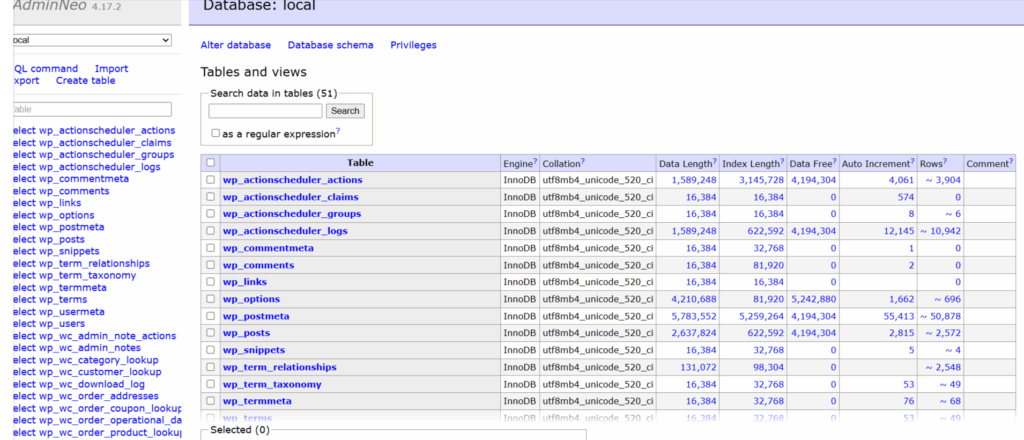
You need to look for wp_posts. Once you have found the table, open it. This is where WordPress holds all the dynamic content.
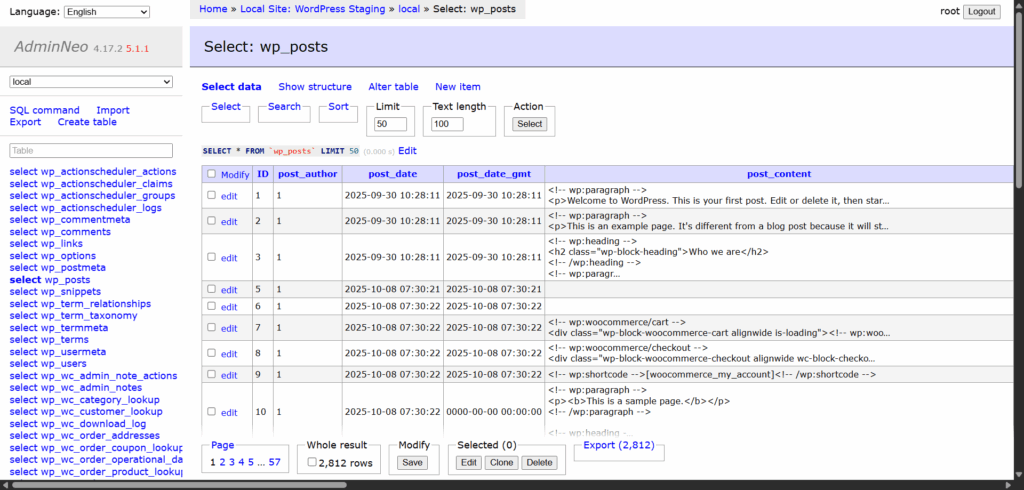
Next, use the available search feature. You can choose the “post_type” filter and enter “page”. This will show you all the pages in the WooCommerce store or WordPress website.
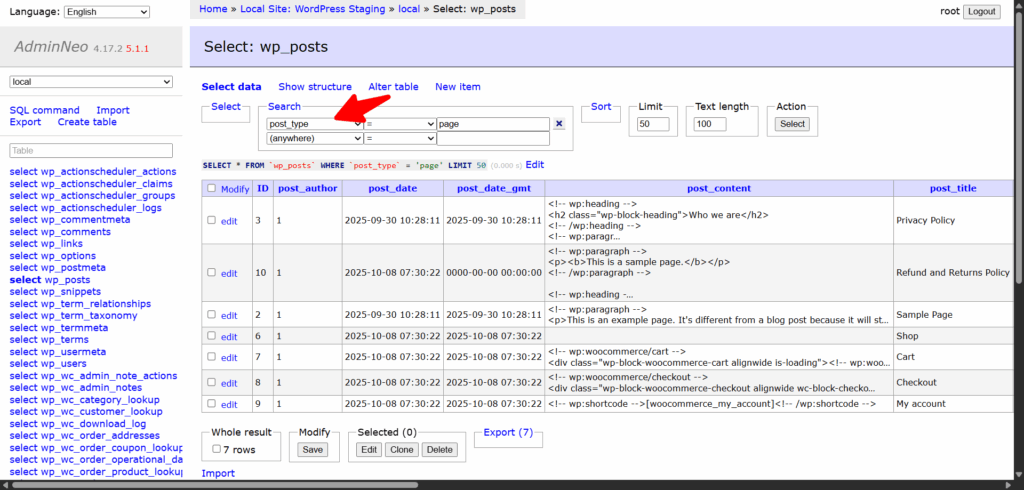
This is where the WordPress pages are stored in your database.
Common Issues Related to Page Storage
- Database Corruption – Improper updates, plugin conflicts, or server errors can corrupt the WordPress database, affecting pages and posts.
- Missing Pages or Posts – Pages may disappear due to accidental deletion or failed migrations.
- Slow Loading Pages – Large amounts of data in the database or unoptimized queries can slow down page loading.
- Incorrect Post Type Assignments – Misconfigured custom post types may cause pages to display incorrectly.
- Backup Failures – Failing to back up the database and files can result in permanent data loss.
- Plugin or Theme Conflicts – Plugins or themes that modify the database can sometimes overwrite or break page storage.
Frequently Asked Questions
Now, let’s take a look at some of the frequently asked questions and answers regarding this topic.
Where are WordPress pages stored?
WordPress pages are stored in the MySQL database, primarily within the wp_posts table. Each page is a dynamic piece of content retrieved whenever someone visits your site.
Are posts and pages stored in the same place?
Yes, both posts and pages are stored in the wp_posts table. They are distinguished by the post_type column, with pages labeled as page and posts as post.
Can I find WordPress pages in the file system?
No, WordPress pages are not static HTML files. While themes and plugins exist in the file system, page content is stored in the database.
How can I access WordPress pages stored in the database?
You can access them using tools like phpMyAdmin, cPanel, or WP-CLI. Always be cautious when modifying content directly.
Why is understanding WordPress page storage important?
Knowing where pages are stored helps with backups, migrations, troubleshooting, and custom development, ensuring your site runs smoothly.
Does WordPress store media files in the database?
No, media files like images and videos are stored in the wp-content/uploads directory, while metadata about these files is stored in the database.
How can I safely back up WordPress pages and posts?
You should manually back up your WordPress database using tools like phpMyAdmin and regularly back up files in your site’s directory to prevent data loss.
Conclusion
Understanding where WordPress pages are stored is essential for effectively managing your WordPress site.
Both posts and pages are stored in the MySQL database, primarily within the wp_posts table, while themes, plugins, and media files reside in the file system.
Knowing this structure allows you to safely back up content, troubleshoot issues, migrate your website, and develop custom solutions. Tools like phpMyAdmin, cPanel, or WP-CLI provide access to your database, but it’s crucial to handle modifications carefully to avoid data loss.
By understanding how WordPress works behind the scenes, you can optimize your site’s performance, protect your content, and manage your WordPress pages and posts efficiently.
This knowledge is a key step toward maintaining a secure and well-organized WordPress website.
Bonus Tips: How to categorize WordPress pages with folders
Now that you know where pages are stored in WordPress, here’s a little secret to make managing them a whole lot easier. Let’s be honest – if your WordPress dashboard looks more cluttered than a renovation site before the final reveal, it’s time to tidy up!
By default, WordPress doesn’t let you categorize your Pages. All your pages, “Home,” “About,” “Living Room Design,” “Client Stories,” “Blog,” are just listed together in one long, flat view.
That might be fine for a small website, but once you start managing dozens of service pages, design portfolios, or client case studies, it quickly becomes overwhelming.
For example, as an interior designer, you already know the power of structure and balance. Your online workspace deserves the same level of harmony – and that’s exactly what CatFolders – WP Media Folders brings to your WordPress site.
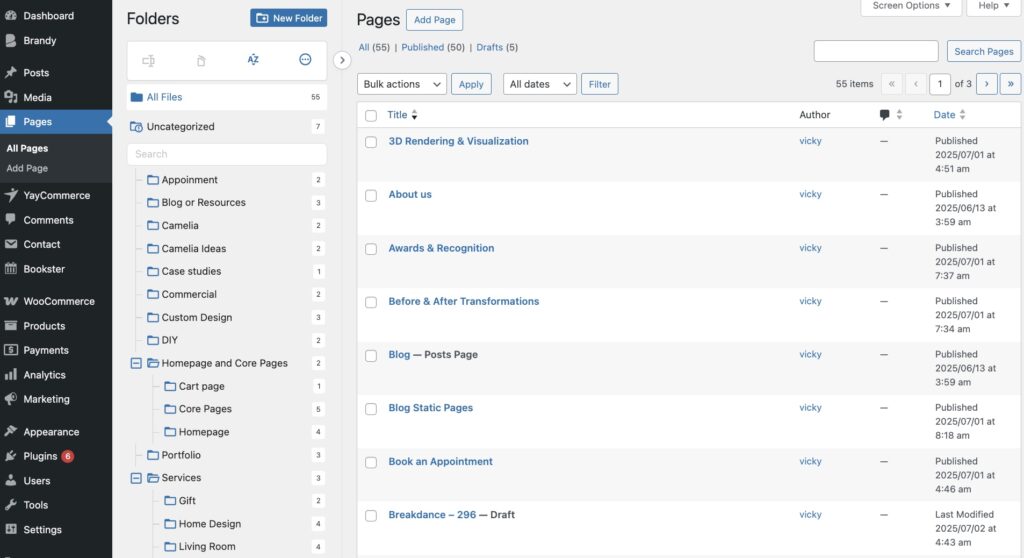
With CatFolders, you can finally organize and categorize your WordPress pages into folders – just like you would group design projects or material samples in your studio. Moreover, you can create folders and subfolders to organize your WordPress Pages just the way you want, by type, status, or even team responsibility. It transforms the Pages screen into a clean, well-structured workspace where everything is easy to find and beautifully organized.
Think of it as designing your digital studio: each folder represents a project, a service, or a collection of ideas. Instead of scrolling endlessly or typing through search bars, you can simply bulk-select pages for drag and drop into folders that make sense to you.
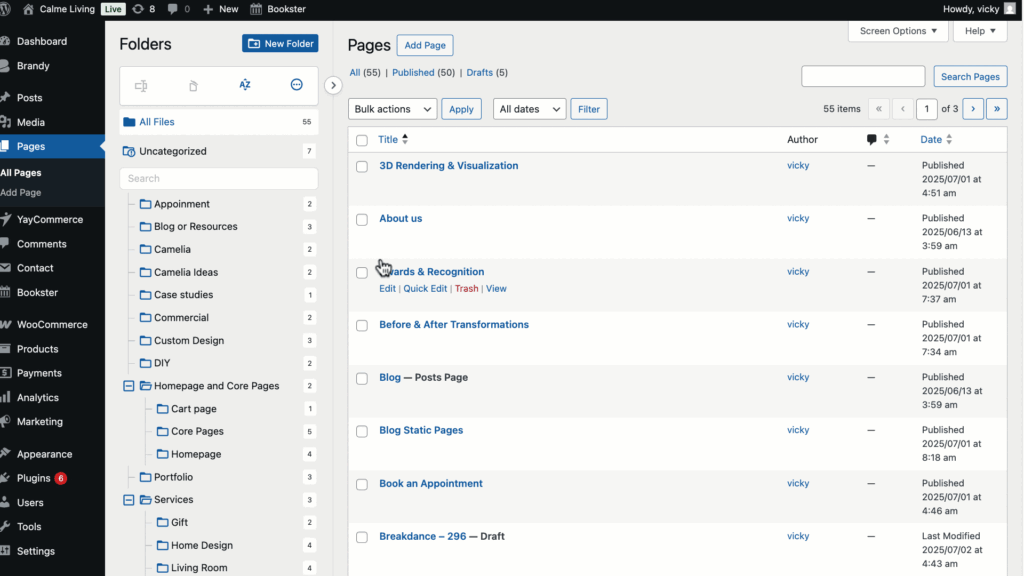
Here’s Why You’ll Love It:
- Categorize WordPress pages effortlessly with drag and drop.
- Keep your dashboard neat, visual, and easy to navigate
- Collapse or expand the folder tree to focus on what you need
- Change folder colors to mark different types or priorities
- Quickly find the pages you need for editing or updates
- Sort your pages by title, date, or custom order
Using CatFolders, your team can streamline workflows and collaborate more effectively by creating folders based on page status or internal follow-up. You can create some folders or subfolders, such as:
- Needs Review: for pages waiting for client feedback
- Design Update Needed: for pages that need new images or layout tweaks
- Under Construction: for pages in progress
- Completed: for pages ready to go live
So, once you’ve found where your pages live in WordPress, give them a little organizational love! CatFolders helps you manage your pages with elegance – turning your site management into an experience as smooth as your interior design process.